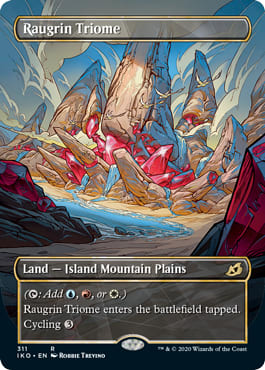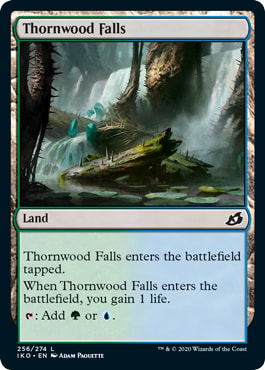Lands are the most underappreciated card type in the game. Far too many players think they are finished building their decks when all they have left is the land. A bad mana base will upend all the work you have done putting together your masterpiece. You want to choose just the right balance of colors and mana so you have the color and numbers to cast your cards when you need to.
Lands can even fill in some of the weaknesses in your decks. Maze of Ith, Slayers' Stronghold, and Kessig Wolf Run aren't in decks because they tap for mana!
I want to spend this article taking a deep dive on the lands in Ikoria. I think we have some great options coming from this set and I want to give you the perspective of someone who loves lands and uses them to their maximum!
Bonders' Enclave
Card draw is a great thing. Every deck generally wants some card draw and getting it on a land is particularly handy. Lands are a permanent type that just don't get destroyed often! This means Bonders' Enclave is going to be a resilient source of card draw once it hits the battlefield.
The three lands that come to mind with this card are Desolate Lighthouse, Grim Backwoods, and Sea Gate Wreckage. Grim Backwoods costs one more and demands a sacrifice. Desolate Lighthouse costs the same, and the drawback of discarding is hardly a drawback at all. Sea Gate Wreckage is the same price, but having no cards in hand is a significant drawback. Much like other lands similar to it, Bonders' Enclave belongs in a specific deck.
So is the rate for a card worth it? While three mana to draw a single card isn't great in Blue, it seems fairly acceptable in most of the other colors. The issue is that it isn't really three mana to draw a card. That same ability on an artifact would mean that it costs three mana to draw a card. However, Bonders' Enclave is a land, not an artifact. The fact that you have to tap Bonders' Enclave, along with three other mana, means that it is actually costing you four mana to draw that card. The mana you could have used that the Enclave can produce is also lost. Now you have to decide, "Will I pay four mana to draw a card?"
There are a three other issues with Bonders' Enclave to consider. The first is the obvious one: you are only going to get to draw a card when you control a creature with a power of four or greater. When you desperately need to draw an out after a Wrath, or you are in trouble because your defenses are weak, you may not be able to draw the card. If you have a four power or greater creature on the battlefield, you are less likely to desperately need the card draw. I think all of us will take an extra card draw at any time, so I can get past this issue, but it is something to consider nonetheless.
A second issue is the colorless mana the card produces. Generally when you play your turn, you want to tap your colorless sources first. By keeping your colored mana open, you are revealing less about what is in your hand. You can play more of the options in your deck, so it leaves your opponents guessing. Many times, you won't want to activate the Enclave until just before the start of your turn, so you can appear to have all kinds of options, even if you don't. This will allow you to dump your extra mana into the Enclave and draw the extra card. While that sounds great, it just means that not tapping the Enclave during your turn is telegraphing a weak hand. On the other hand, tapping it on your turn, especially for mana, suggests you do have something you are trying to hold up for your opponents' turn, since you have given up the option of drawing a card for the extra mana. Of course, if you are tapping out for something big, then whether you are hiding something in hand, may just be moot.
Finally, this card suffers from the TFGS. Temple of the False God Syndrome means that the land isn't particularly useful in the early stages of a game. Bonders' Enclave can tap for a mana on turn one, but it is colorless mana. On the early turns of a game, you are often looking for a particular color of mana, so there is a downside there. Also, during those early turns you are rarely going to have three other mana, and a four-power or more creature around to draw more cards. Bonders' Enclave is looking to shine in the mid and late game, rather than early on when you need every mana you can get just to get a couple creatures out there to set up a defense.
Much like Temple of the False God though, this weakness can be mitigated with some careful mulligans. If you have two Plains and a Bonders' Enclave in your opening hand and your only early play is Ash Zealot, you might want to toss it back. Some careful decision-making and awareness of the Enclave's limitations, and it will be a great card!
I happen to have the perfect deck in mind for it!
Divine Squirrels | Casual | Bruce Richard
- Creatures (9)
- 1 Jade Mage
- 1 Oviya Pashiri, Sage Lifecrafter
- 1 Selfless Spirit
- 1 Trostani, Selesnya's Voice
- 1 Wayfaring Temple
- 4 Earl of Squirrel
- Planeswalkers (1)
- 1 Huatli, Radiant Champion
- Instants (2)
- 1 Aura Mutation
- 1 Seed Spark
- Sorceries (5)
- 1 Martial Coup
- 2 Cultivate
- 2 Kodama's Reach
- Enchantments (14)
- 1 Cathars' Crusade
- 1 Doubling Season
- 2 Alpha Status
- 2 Anointed Procession
- 2 Growing Rites of Itlimoc
- 3 Divine Visitation
- 3 Smothering Tithe
- Artifacts (5)
- 1 Helm of the Host
- 2 Blade of Selves
- 2 Fireshrieker
- Lands (24)
- 5 Forest
- 5 Plains
- 2 Selesnya Sanctuary
- 2 Sunpetal Grove
- 3 Bonders' Enclave
- 3 Temple of Plenty
- 4 Bountiful Promenade
This deck is a ton of fun to play, turning a bunch of 1/1 squirrels into 5/5 Squirrel Angels. This happens regularly in the deck and allows you to draw plenty with Bonders' Enclave. In fact, the deck's biggest issue is getting to the point where you can do it, then seeing part of the combo get destroyed. With Bonders' Enclave, you get the chance to find another copy of Divine Visitation so you are ready to roll when the first one is destroyed.
Triomes (Indatha, Ketria, Raugrin, Savai, Zagoth).
These lands have it all. First off, they tap for three colors of mana, so you know they are going to be wonderful in your Doran and Pramikon decks, along with any other deck that is running those colors.
Secondly, they list the three basic land types on the type line, so you can search for them with your fetch lands or any card that allows you to search for a land type! Farseek, Tithe, and other cards like them just got a little better.
Finally, you can cycle them. When you reach those later stages in the game, or that point where you just must have a particular card right away, you can spend three and send them to the graveyard to draw another card. Then from the graveyard they can be food for all sorts of broken recursion cards.
There is practically no downside at all to these cards! Okay, they enter the battlefield tapped. Let's talk about that for a minute. There are going to be a lot of people who read down to that line of text and discarded these lands. This has been a drawback on lands for a very long time and it is often seen as the kiss of death on a land. Simply put, a game of Magic doesn't last for as many turns as you think. It is rare to find a Commander game with good decks that goes for ten turns. If you draw this as your land for turns two through five, you are likely falling behind. That is the difference between stealing victory and taking another loss.
Some of us feel differently about that though. Entering the battlefield tapped is a downside but should it strike the card from your consideration completely? My playgroup tends to play games with less powered decks. You only have to look at the Divine Squirrels deck to know that. These less powered decks allow games to run longer, meaning that entering tapped still hurts for a turn, but with more turns, it is a smaller percentage of the game.
The ability to search for the land helps to limit the suffering. If you search for the card at the end of an opponent's turn, it will untap on your turn, so in those situations too, you won't notice that it entered tapped.
The ability to cycle is another mitigating factor to entering tapped. In situations where entering tapped is truly bad, you can still cycle it away and hope for something better!
Finally, as someone who regularly runs the Temples from Theros, running a few lands that enter tapped is just fine, particularly if they have an upside. The ability to scry 1 more than makes up for the limitation in that scenario for me. The ability to tap for any of those three colors makes up for it here too. I also regularly run the Shock lands from Ravnica and I rarely put them into play untapped. As the game progresses, I may not need the land that turn or I can find a line of play that doesn't involve having to take two damage. As long as you are running about 40% lands in your decks, an occasional enter the battlefield tapped land is just fine. Don't go too crazy and run only basics and lands that enter tapped, but I would make room for cards like these.
Gain a life lands
These have been around for a while now and are available from other sets. While I don't think running lands that give you one life is a reason to run an enter the battlefield tapped land, I did just list off several reasons why I still run lands that enter the battlefield tapped and will continue to do so.
I will say that if you are just getting into Magic, or have only been playing for a couple of years, hang on to these when you find them. They will serve you well until your collection includes full sets of the spectacular lands that tap for more than one color of mana coming up in future sets.
I hope you enjoyed our sojourn through the lands in Ikoria! While I wouldn't recommend building any permanent structures there, picking up real estate is rarely a bad investment.
Bruce Richard
































